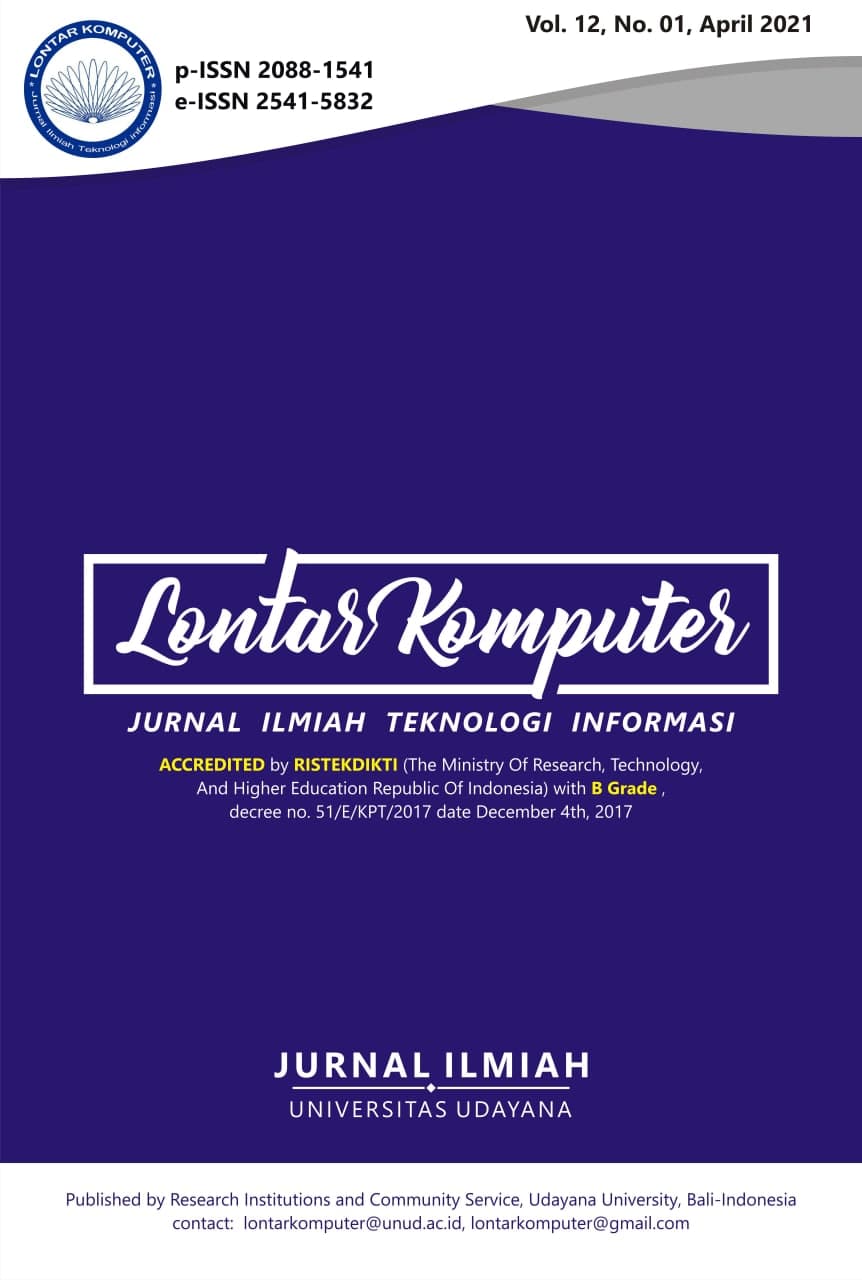Augmented Reality Application using Dynamic Location-Based Tracking of Taman Ayun Temple
Abstract
Taman Ayun Temple is a world cultural heritage in Bali. Based on observations, information regarding the location at Taman Ayun Temple is still not optimal. This study aims to design an application that displays location information using markerless augmented reality. Markerless AR is a technology that displays virtual objects into the real world using GPS, digital compass, and accelerometer. The application is designed using the Wikitude SDK platform and displays information on location, description, image, distance from the user, and location direction. Data is stored in a database server and managed using the web server. Applications are in Indonesian and English. The testing compares the actual distance with the distance displayed in the application using devices with different OS and RAM. Application speed is less than 1 second depending on RAM and internet speed, while location accuracy depends on smartphone GPS accuracy with a difference of less than 10 meters from the actual distance.
Downloads
References
[2] S. Saleh, "Kerukunan Umat Beragama di Denpasar Bali," Rumah Jurnal AL-FIKR, vol. 17, no. 1, pp. 167-175, 2013.
[3] A. A. Munandar, Istana Dewa Pulau Dewata, Depok: Komunitas Bambu, 2005.
[4] I. W. Ardika and I. N. Subadra, Warisan Budaya Dunia Pura Taman Ayun dan Pura Tirta Empul Sebagai Daya Tarik Wisata di Bali, 1st ed., Denpasar-Bali: Pustaka Larasan, 2018.
[5] S. C.-Y. Yuen, G. Yaoyuneyong and E. Johnson, "Augmented reality: An overview and five directions for AR in education," Journal of Educational Technology Development and Exchange, vol.4, no. 1, pp. 119-140, 2011, doi: 10.18785/JETDE.0401.10.
[6] L. R. Andhika, “Model Sistem Dinamis: Simulasi Formulasi Kebijakan Publik (Dynamic System Model: Simulation Method in Formulation Public Policy)”, Jurnal Ekonomi & Kebijakan Publik, vol. 10, no. 1, pp. 73-86, 2019.
[7] I. B. N. Ligia Prapta, I. K. G. Darma Putra and I. M. A. D. Suarjaya, “Aplikasi Augmented Reality Dinamis Pengenalan Huruf Kanji (AR-Kanji) Berbasis Android”, Jurnal Merpati (Menara Penelitian Akademika Teknologi Informasi), vol. 6, no. 3, pp. 185-191, 2018, doi: 10.24843/JIM.2018.v06.i03.p05.
[8] I. A. P. W. Astiti, G. M. A. Sasmita and M. Sukarsa, “Penerapan Augmented Reality Video Dinamis dalam Pembelajaran Peredaran Darah Berbasis Android”, Jurnal Merpati (Menara Penelitian Akademika Teknologi Informasi), vol. 6, no. 3, pp. 174-184, 2018, doi: 10.24843/JIM.2018.v06.i03.p04.
[9] A. F. Waruwu, I. P. A. Bayupati and I. K. G. Darma Putra, "Augmented Reality Mobile Application of Balinese Hindu Temples: DewataAR", International Journal Computer Network and Information Security, vol. 2, no. 7, pp. 59-66, 2015, doi: 10.5815/ ijcnis.2015.02.07.
[10] I. K. G. Darma Putra, I. M. Suwija Putra and I. N. Adi Triginarsa, "Augmented Reality Mobile Application of Balinese Story: LubdakaAR," The European Journal of IT and Project Management, 2019.
[11] A. A. N. H. Susila and D. M. S. Arsa, "Aplikasi Augmented Reality Pengenalan Bangunan Adat Desa Penglipuran," Jurnal Media Informatika Budidarma, vol. 4, no. 3, pp. 726-734, 2020, doi: 10.30865/mib.v4i3.2208.
[12] I. A. Fikri, D. Herumurti and H.R. Rahman, "Aplikasi Navigasi Berbasis Perangkat Bergerak dengan Menggunakan Platform Wikitude untuk Studi Kasus Lingkungan ITS," Jurnal Teknik ITS, vol. 5, no. 1, p. 48, 2016, doi: 10.12962/j23373539.v5i1.14511.
[13] I. G. A. Nugraha, I. K. G. Darma Putra and I. M. Sukarsa, “Rancang Bangun Aplikasi Android AR Museum Bali : Gedung Karangasem dan Gedung Tabanan”, Lontar Komputer, vol. 7, no. 2, pp. 93-103, 2016, doi: 10.24843/LKJITI.2016.v07.i02.p03.
[14] S. N. Adnin, I. B. K. Widiartha and I. M. Suksmadana, “Pembuatan Aplikasi Catalog 3D Desain Rumah Sebagai Sarana Promosi Dengan Menggunakan Unity3D”, Lontar Komputer, vol. 7, no. 1, pp. 1-12, 2016, doi: 10.24843/LKJITI.2016.v07.i01.p01.
[15] I. D. G. W. Dhiyatmika, I. K. G. Darma Putra and N. M. I. M. Mandenni, “Aplikasi Augmented Reality Magic Book Pengenalan Binatanguntuk Siswa TK”, Lontar Komputer, vol. 6, no. 2, pp. 120-127, 2015.
The Authors submitting a manuscript do so on the understanding that if accepted for publication, the copyright of the article shall be assigned to Jurnal Lontar Komputer as the publisher of the journal. Copyright encompasses exclusive rights to reproduce and deliver the article in all forms and media, as well as translations. The reproduction of any part of this journal (printed or online) will be allowed only with written permission from Jurnal Lontar Komputer. The Editorial Board of Jurnal Lontar Komputer makes every effort to ensure that no wrong or misleading data, opinions, or statements be published in the journal.
 This work is licensed under a Creative Commons Attribution 4.0 International License.
This work is licensed under a Creative Commons Attribution 4.0 International License.























